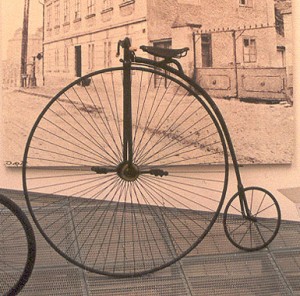 Happy Bike Month, everyone!
Happy Bike Month, everyone!
To get us started right, let’s travel back in time to 1817, and see how far those two wheeled wonders have come.
The bicycle started as a “walking machine” to propel inventor Baron von Drais more quickly through royal gardens. They were about the same size as modern bikes, with wheels of the same size, but no pedal. Instead the rider straddled the frame and pushed himself along in a glide. Also called the “Draisienne,” the wooden machine wasn’t much good on anything but well manicured pathways.
In 1865, someone applied pedals to the front wheel, and the velocipede (“fast foot”) was born! The thing was still made of wood, so it earned the nickname “boneshaker” for its wobbly rides across mostly cobblestoned roads. Velocipedes were popular enough to lead to the creation of indoor riding clubs, offering people the chance for a smoother ride.
In 1870, advancements in metallurgy allowed for the creation of the first all metal bike. Rubber tires emerged around this time, too. These lighter bikes gained popularity, even though they still had no brakes and were effectively all fixies.
 Someone figured out that larger front wheels offered a better return on your effort, and cartoonishly large front wheels came into vogue. One of these bikes cost an average of six month’s pay, but they were popular nonetheless. Riders purchased bikes with front wheels as large as their legs would allow.
Someone figured out that larger front wheels offered a better return on your effort, and cartoonishly large front wheels came into vogue. One of these bikes cost an average of six month’s pay, but they were popular nonetheless. Riders purchased bikes with front wheels as large as their legs would allow.
Of course, this was incredibly hard to control, and these bikes were given to flipping forward. Hitting a larger than average rut or rock would send the rider head-first over the wheel.
Improvements continued. Soon, someone realized they could put the big wheel on the back of the bicycle to reduce that annoying “flipping head-first over the handlebars” problem. This revolutionary design became known as a “safety bicycles”, while the older style was referred to as “ordinary bicycles” or “ordinaries.”
A few years later, metallurgy advanced sufficiently to allow chains and the all important gear differentials. You could pedal once but propel the bicycle more than one turn of the wheel! With a few final improvements to the rubber tires in 1898 (by the father of a boy named Dunlop), the modern bicycle was born. Improved production technologies meant that working men could afford them, and bicycles were much cheaper than horse-drawn carriages.
Bicycles also played an important role in the course of women’s rights. In 1896, Susan B. Anthony said that “the bicycle has done more for the emancipation of women than anything else in the world.” The bicycle craze effectively killed the corset while ushering “common sense dressing” and increased the mobility of women tremendously.
Bicycling was so popular in the late 1800’s that the League of American Wheelman formed to lobby for better roads. Soon, those roads began serving an even newer technology – cars.
Today’s bicycles are of course a refined version of their ancestors at the turn of the last century, but the basic concept is still the same. And the League of American Wheelman (now the League of American Bicyclists) is still lobbying for more bicycle-friendly roads.
The history of bicycles is far from complete.
Many people in the developing world still suffer from a lack of cost-effective and reliable transportation. What does a bicycle represent to a child who must walk eight miles to school, or a would-be entrepreneur who must carry their goods a similar distance to market? Non-profits like Bikes Not Bombs are working to bring sturdy and rugged bicycles to people that need them around the world.
In our own country, the comfort of “safety bikes” was supplanted long ago by air-conditioned, self-propelled automobiles. But as we strive to solve our public health and climate change problems, bicycles present a new set of opportunities here, too.
